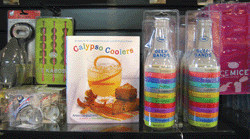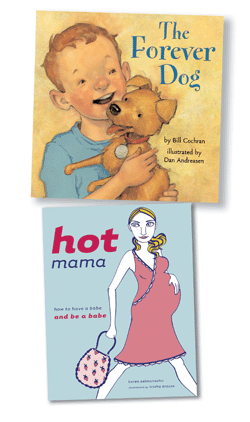Go By The Book
Gift Books Are Big Business
The gift-book business is big business.
 For many publishers it’s the gift books, or rather the sale of books in nontraditional outlets—called “special markets” in the book industry—that provide the growth for an otherwise sluggish market. According to the Association of American Publishers, book sales for 2006 were slightly lower than in 2005, but the numbers hovered at a little over $10 billion for both years.
For many publishers it’s the gift books, or rather the sale of books in nontraditional outlets—called “special markets” in the book industry—that provide the growth for an otherwise sluggish market. According to the Association of American Publishers, book sales for 2006 were slightly lower than in 2005, but the numbers hovered at a little over $10 billion for both years.
“The bookstore market is stagnant, and the individual stores and chains are not growing. Publishers are looking for alternative venues,” says J. McCrary, senior director of special markets for The Perseus Books Group, a publisher and distributor headquartered in New York City.
Who? Where?
The diversity of these alternative venues has been increasing dramatically. “Over the course of the last 20 years, it’s phenomenal where the placement of books in the special market has grown and grown and grown,” says Chris Tudor, Northwest sales representative for Workman Publishing Co., in New York City. “Both the quantity of gift stores [carrying books] and the quantity [of books] they’re carrying is going up,” says Dennis Hayes, a trade show director, with six years’ experience as special markets director, at the Berkeley, CA-based nonfiction book publisher Ten Speed Press. From carrying a single title to a spinner rack of 72 plus, “more retailers in the gift market realize that books make a great sideline, and in many accounts, books are a part of their core mix of products,” says Pam Roman, director of specialty sales for Random House Special Markets in New York City.
Everyone—general gift shops, gourmet and pet stores—is getting in on the action. Special-market books can be sold anywhere, because there is a title for virtually every target audience. Special markets, unlike bookstores, don’t necessarily have to stock only newly published books. Backlisted books, defined as older books still kept in print, can also be considered.
So there is an even larger selection of interesting titles to choose from. For example, says Hayes, a store that is looking to do a summer special might stock a book about sunflowers, regardless of its publication date, because the book offers the store the right summer look.
Many backlist titles enjoy solid, steady sales. In some cases, sales can exceed initial publication runs, according to Hayes. Menopaws: The Silent Meow (Martha Sachs), a book in which cats play the roles of women, “quietly disappeared in more traditional book sales outlets, but once the gift market caught on to it, its sales continued to grow for over six years, ” Hayes says. “It has sold 215,000 copies to date.”
The gift shop edge
 Where in bookstores titles are often lined up side by side on shelves, they receive special attention in gift stores. “Gift store retailers understand the merchandising aspect better. They may only have 12 books, but chances are they out-merchandise the bookstore every time,” says Hayes. The trick is effective cross-merchandising. Giving books their own shelf, or section, is definitely not the idea here (unless of course you already have a loyal book following). The idea is to make books fit in with various themes throughout your store.
Where in bookstores titles are often lined up side by side on shelves, they receive special attention in gift stores. “Gift store retailers understand the merchandising aspect better. They may only have 12 books, but chances are they out-merchandise the bookstore every time,” says Hayes. The trick is effective cross-merchandising. Giving books their own shelf, or section, is definitely not the idea here (unless of course you already have a loyal book following). The idea is to make books fit in with various themes throughout your store.
If you have a summer barbecue section, a book on grilling would work well. Or maybe you sell a lot of children’s toys, and a children’s classic would fit the bill. Use books to complement and add to themes already in place. The bottom line: If they’re related items, put them together, says Frank Minella, manager of Beeps, a gift store in Albuquerque, NM, that has sold an eclectic selection of book titles for more than 22 years. Beeps displays many types of books in many different sections throughout the store: Martini books are sold with barware, pet books are in the pet section, and so on.
“In a well-merchandised store, with lots of higher-priced, attractive surrounding products—whether home decorations, furniture or clothing—there is a real ‘pop’ to our products that calls attention to them,” says Michael Flynn, vice president of sales and marketing for Compendium Inc., a publisher and gift manufacturer in Seattle.
While one or two copies of a particular book can be used to create an effective cross-merchandising display, remember to also stack multiple copies of the same book close by. “Retailers should always buy more than one copy of any title in order to make a statement, and to give the message that the books are for sale, not just for display,” says Roman, from Random House. Carrying fewer titles and going deeper with each one is preferable to carrying a small amount of many different titles, says Tudor, from Workman. “It’s a bigger impact. It gets people talking and the momentum keeps it selling,” she says.
Would you like a book to go with that?
 It goes without saying: Cross-merchandising encourages add-on sales. When your customer buys the book, an add-on sale can be achieved. Lisa Bach, senior special sales manager for Chronicle Books, in San Francisco, gives an example: “Take a cookbook merchandised among colorful mixing bowls in a gourmet section. Once a reader delves into the recipes and discovers she needs a mixing bowl, she’ll find a nice selection within easy reach.”
It goes without saying: Cross-merchandising encourages add-on sales. When your customer buys the book, an add-on sale can be achieved. Lisa Bach, senior special sales manager for Chronicle Books, in San Francisco, gives an example: “Take a cookbook merchandised among colorful mixing bowls in a gourmet section. Once a reader delves into the recipes and discovers she needs a mixing bowl, she’ll find a nice selection within easy reach.”
Of course, cross-merchandising works just as well the other way around. A set of martini glasses bought as a gift can be complemented by a gift book (such as Ultimate Bar Book: The Comprehensive Guide to Over 1,000 Cocktails, by Mittie Hellmich). Some books come in sizes that make attractive impulse additions to a larger gift. The Totally Garlic Cookbook and The Totally Mushroom Cookbook, both co-authored by Helene Siegel and Karen Gillingham, die-cut in the shapes of garlic and mushrooms, and the size of a large apple, are examples of add-on sales possibilities. Totally Garlic has sold more than 550,000 copies. Hayes, of Ten Speed Press, publisher of Totally Garlic, credits approximately 90 percent of these sales to special markets.
Books and branding
 Hayes points out that books also help in subjective ways that are less easy for retailers to quantify. For one, they can anchor your customers inside your store. Picture a husband waiting for his wife to get done shopping. Chances are a book will hold his attention long enough to let his wife shop (and increase your sales).
Hayes points out that books also help in subjective ways that are less easy for retailers to quantify. For one, they can anchor your customers inside your store. Picture a husband waiting for his wife to get done shopping. Chances are a book will hold his attention long enough to let his wife shop (and increase your sales).
Stocking a certain kind of book also helps you convey your store’s brand image. Beeps stocks a wide variety of books that help maintain its “edgy” image, says Minella. These include: Gangsta Rap Coloring Book, by Aye Jaye, and Still Lovers, by Elena Dorfman, a book about the complex relationship between sex dolls and their owners.
What sells?
There are many popular categories of books on the market today. To choose the most successful titles, hone in on your niche and your customer base. That said, some categories sell well across the board. Many industry sources point out successes in the gourmet and cocktail categories. For gift store retailers who sell kitchen and entertaining items, these books are simple additions. Children’s books are also hot.
Rick Speicher, co-owner of ISBN Sales, a rep group in Yardley, PA, that serves more than 1,000 accounts in the mid-Atlantic region, says children’s is the company’s number one category. And McCrary notes that The Perseus Books Group is rapidly adding to its kids’ titles to fill increased demand.
Girlfriend-to-girlfriend books are also strong. Hayes says as much as 70 percent of Ten Speed’s gift books are marketed to women. And luxury books, with luxurious packages (think audio capability and carrying cases) and luxurious price tags, are trending up. “We have a lot of titles on our fall 2007 list that fall into this category, as these kinds of books are published specifically for the fourth quarter/ holiday sales,” says Bach, at Chronicle Books.
The take-home message is: If you’re in the gift retail business, it may be time to give a few titles a whirl. “We’ve come a long way, but there’s still a long way to go for buyers to realize the significance of a book as a gift item,” says Tudor, of Workman Publishing. Great gifts, great add-ons, great merchandising tools. It all adds up to great sales, if you do it “by the book.”























